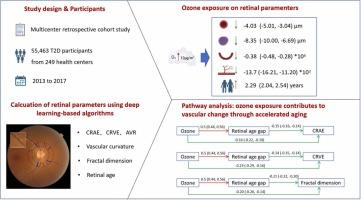Ozone exposure, retinal microvasculature alterations, and the mediating effect of aging in diabetic population: A retrospective cohort study
IF 6.1
2区 环境科学与生态学
Q1 ENVIRONMENTAL SCIENCES
引用次数: 0
Abstract
Accumulating epidemiological evidence links ozone exposure with cerebrocardiovascular morbidity, yet its microvascular impact remains poorly characterized. Retinal microvasculature alterations have emerged as sensitive biomarkers of systemic endothelial dysfunction and predictors of cerebrocardiovascular events. Our study comprised 55,463 individuals diagnosed with type 2 diabetes mellitus (T2DM), recruited across 249 community health centers spanning all 17 administrative districts of Shanghai in 2017. Exposure assessment utilized satellite-derived ozone concentration estimates at 1*1 km spatial resolution, aggregating five-year (2013–2017) ozone exposure metrics. Retinal vascular phenotyping included central retinal artery equivalent (CRAE), central retinal vein equivalent (CRVE), arteriole-to-venule ratio (AVR), vascular tortuosity (VT), and fractal dimension (Df). The retinal age gap (RAG) is adopted to reflect accelerated aging, defined as the difference between deep learning-predicted retinal age and chronological age. Multivariable regression analyses using double machine learning showed that for every 10 μg/m3 increase in ozone, the decrease in the CRAE, CRVE, VT (×104) and Df (×103) were 4.03 (95 %CI: 3.04, 5.01)μm, 8.35 (95 %CI: 6.69, 10.00)μm, 0.38 (95 %CI: 0.28, 0.48) and 13.7 (95 %CI: 11.20, 16.21), respectively, and the increase in RAG was 2.29 (95 %CI: 2.04, 2.54) years. Mediation analysis revealed an association between ozone exposure and reductions in CRAE (indirect effect, standardized coefficient=-0.08, 95 %CI −0.09∼-0.07), CRVE (-0.07, −0.08∼-0.06), and Df (-0.11, −0.12∼-0.09) through the pathway of accelerated aging. Long-term ozone exposure correlates with accelerated retinal aging and microvascular remodeling (vessel narrowing, reduced tortuosity, fractal simplification), which provides novel biological evidence to elucidate the causal relationship between ozone exposure and cerebrocardiovascular risk.

臭氧暴露、视网膜微血管改变和糖尿病人群衰老的中介作用:一项回顾性队列研究。
越来越多的流行病学证据表明臭氧暴露与脑血管疾病有关,但其对微血管的影响仍不清楚。视网膜微血管改变已成为全身性内皮功能障碍的敏感生物标志物和脑血管事件的预测因子。我们的研究包括55,463名诊断为2型糖尿病(T2DM)的个体,于2017年在上海所有17个行政区的249个社区卫生中心招募。暴露评估利用1*1 公里空间分辨率的卫星衍生臭氧浓度估计值,汇总了5年(2013-2017年)臭氧暴露指标。视网膜血管表型包括视网膜中央动脉当量(CRAE)、视网膜中央静脉当量(CRVE)、小动脉与小静脉比(AVR)、血管弯曲度(VT)和分形维数(Df)。采用视网膜年龄差距(RAG)来反映加速老化,定义为深度学习预测的视网膜年龄与实足年龄之间的差异。采用双机器学习的多变量回归分析表明,臭氧每增加10 μg/m3, CRAE、CRVE、VT (×104)和Df (×103)分别减少4.03(95 %CI: 3.04, 5.01)μm、8.35(95 %CI: 6.69, 10.00)μm、0.38(95 %CI: 0.28, 0.48)和13.7(95 %CI: 11.20, 16.21)年,RAG增加2.29(95 %CI: 2.04, 2.54)年。中介分析显示,臭氧暴露与通过加速老化途径降低CRAE(间接效应,标准化系数=-0.08,95 %CI -0.09 ~ -0.07)、CRVE(-0.07, -0.08 ~ -0.06)和Df(-0.11, -0.12 ~ -0.09)之间存在关联。长期臭氧暴露与视网膜老化加速、微血管重构(血管狭窄、弯曲减少、分形简化)相关,为阐明臭氧暴露与脑血管风险的因果关系提供了新的生物学依据。
本文章由计算机程序翻译,如有差异,请以英文原文为准。
求助全文
约1分钟内获得全文
求助全文
来源期刊
CiteScore
12.10
自引率
5.90%
发文量
1234
审稿时长
88 days
期刊介绍:
Ecotoxicology and Environmental Safety is a multi-disciplinary journal that focuses on understanding the exposure and effects of environmental contamination on organisms including human health. The scope of the journal covers three main themes. The topics within these themes, indicated below, include (but are not limited to) the following: Ecotoxicology、Environmental Chemistry、Environmental Safety etc.

 求助内容:
求助内容: 应助结果提醒方式:
应助结果提醒方式:


